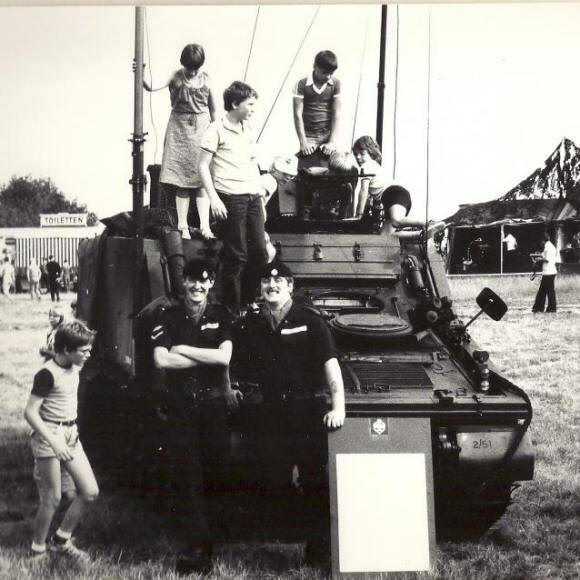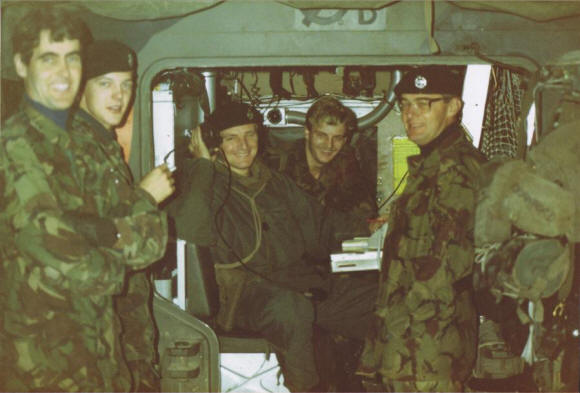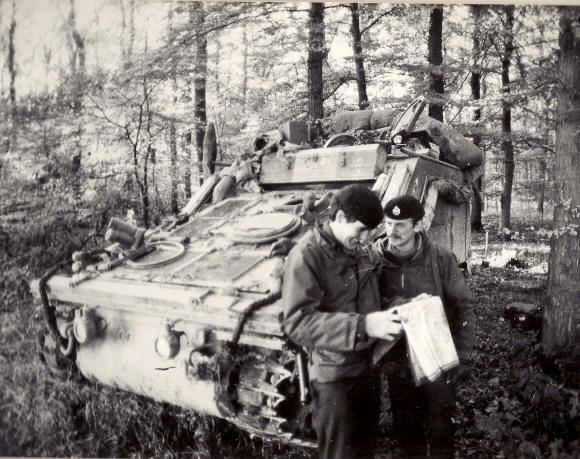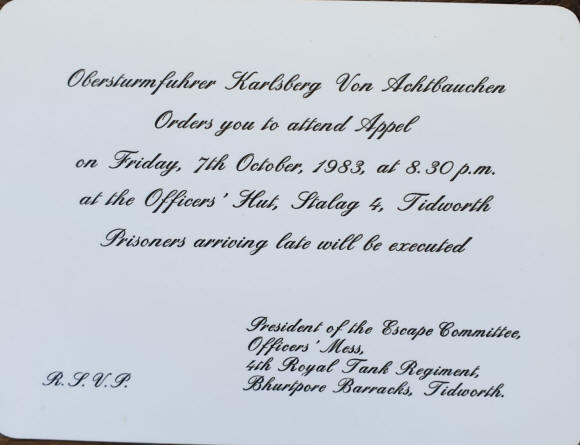|

ALL GOOD
THINGS come to an end, and so it was for my all too
brief period as troop leader of 13 Troop, D Squadron,
4th Royal Tank Regiment. It was time for me to move
further up the greasy pole of career progression and I
was sent on the Regimental Signals Officer (RSO) course
at Bovington Camp in Dorset. The choice was either the
RSO course, or the Regimental Gunnery Officer (RGO)
course, or the Driving and Maintenance (D&M) course. I
wasn’t really that interested in gunnery, although my
crew could put a DST round through the eye of a needle
at 2000 metres nine times out of ten, nor was I into
engines and mechanics. So signals it was.
I will pass on the details of the course except to say I
nearly killed myself when my new car skidded on black
ice in Poole and sent me careering into a lamppost. An
evening in A&E followed, but I was OK and got back in
the wee small hours with multiple stitches in an
impressive head wound. I was later outraged to get a
bill for £540 from the local council for replacing the
said lamppost, but luckily my insurance covered it. Back
in Germany I took over my new troop.
Command Troop was essentially Regimental Headquarters (RHQ)
in the field, transformed into Battlegroup (BG) HQ for
training for operations. It was the glue that held all
the other bits together and tended to cream off the best
individuals from the squadrons to man it. Often a time
in Command Troop was a precursor to promotion so, much
as those chosen to its elitist ranks might squeal about
it, they knew that it was a bit of a compliment and
would probably lead to greater things.

4RTR HQ
As an
aside, and whether by accident or design I don’t know,
but all the individuals in Command Troop – myself
included – were/are really good looking. Consequently we
were always in demand for military displays and the
like, and always besieged at them by hordes of pretty
women. In quiet moments of reflection we sometimes used
to blame ourselves for being too available, but we felt
it was our duty. Many of us have continued with this
important work in our later careers with considerable
success.
Back on track. In the field Command Troop deployed
several vehicles; there was the CO’s tank, a couple of
Ferret Scout Cars (FSCs), and three CVR(T)1 Sultan
command vehicles plus an assortment of others. Two of
the Sultans were command vehicles proper with various
radio rigs whilst the third was a planning vehicle used
by the intelligence and NBC bods. The Sultans had a
pull-out sort of gazebo type arrangement at the back, so
you would back up one of the command vehicles with the
planning one and make a small, tented area for extra
room. If we had the Gunners (hawk, spit) or the
Engineers attached we could form a cruciform arrangement
as required. Getting it set up in the middle of the
night took some practice, mind.
The other command Sultan would be positioned some way
off and would act as “step up”. In a fast moving
tactical scenario where we had to move HQ it would go
off to some new location and take over control,
whereupon the rest of the troop would pack up and move
to join them and set up BG HQ again. And so on and so
forth. One of the Ferrets was the “rebro” FSC, driven by
"The Breed" and commanded in my time by Cpl Scooby
Taylor (Main picture above: standing right with LCpl
(now Lt Col!) Neile Kellet).
I initially thought "The Breed's" nickname originated
from his penchant for a good, fresh pan loaf, but in
fact it related to his alleged similarity to a character
in a horror film popular around that time. Anyway,
because the VHF radios we used were more or less
line-of-sight, in hilly or urban terrain there could be
difficulty communicating with sub units, which is where
the rebro came in. It would be sent off at short notice
to sit on top of a hill somewhere where it received the
command net signal on one set frequency and rebroadcast
it on its second set on a different frequency, thereby
establishing comms. It worked very well too, though in
wartime it would have lasted for about two minutes given
the Soviets’ direction finding capabilities. Medals all
round, though.
Command Troop worked really, really hard and being out
on exercise could be extremely exhausting. But as ever
there were some great characters among the boys and we
laughed a lot, even when we were miserable. It would be
unfair to single any one member out because they were
all great soldiers, but perhaps I should just mention my
Troop Sergeant, Peter Reid, who was probably the finest
soldier in the field I ever had the good fortune to
serve alongside, although there are many other
contenders for that title.

The author with Sgt Peter Reid (right)
Then,
suddenly it seemed to me although it had been ages in
the planning, we were on our way back to the UK to
Tidworth, the historic garrison town on Salisbury Plain.
We swapped with the Queen’s Royal Irish Hussars (QRIH),
a nice enough bunch, handed over everything in Yorke
Kaserne to them – including our tanks – and then took
over all their stuff in England. Most of this fell upon
the QM and QM (Tech) and their staffs, plus of course
the boys on the tank park. I drove back halfway through
the process with fellow subaltern Alan Dunlop in my new
VW Golf GTi, the young officers’ car of choice at the
time.
It was a bit odd being back in the UK to be honest. 4th
Tonks had been in Munster since 1974 and therefore it
took a bit of getting used to initially, but we settled
in soon enough. I guess we saw the local area and towns
with European eyes and thought them all a bit quaint at
first, but that soon passed. With three tank squadrons
in Aliwal Barracks in Tidworth and A Squadron in
Warminster we became “rent-a-tank” for the UK army and
spent a lot of time out on Salisbury Plain on various
wheezes. Our recce troop in particular seemed to spend
more time in the field than it did in barracks.
Having handed over the mighty Command Troop to another
when we moved, I now seemed to have a bewildering
succession of jobs in a shortish space of time – 2ic of
C Squadron, Ops Officer in RHQ, even Assistant Adjutant
for about a week until I managed to wriggle out of that
one. Much time was spent by everyone catching up on
various courses as we were much closer to the various
schools that taught our trades and we could fill
vacancies at short notice. I went off and completed the
Junior Division of Staff College at Warminster, of which
I have nothing to report except to say it was mercifully
short.
Socially, our lives had changed quite dramatically too.
As we were now “back home”, it was much easier – and
cheaper – to travel to see friends and family.
Consequently the Officers’ Mess tended to be quiet over
the weekend, as did the barracks as a whole. Being
Orderly Officer on a Saturday and Sunday was much more
irksome than it had been in January, and the possibility
of getting awarded “extras” by the Adjutant for some
misdemeanour or other was so much more of a powerful
threat. On the plus side, it was much easier for us to
have visitors and the Mess seemed to be frequently full
of girlfriends and others. We had some great parties as
well. The PoW party we held when we converted the ante
room into a prisoners’ barrack room in Stalag Luft VIII,
complete with sandbagged machine gun post and dummies in
full German uniform outside the main entrance, being a
particularly memorable one.

PoW party invite
Our local
pub of choice was the White Horse at Thruxton just next
to the famous racing circuit. We could be found there
any day of the week but for some reason Tuesday evenings
became the standard fixture. I have many a memory of
being driven back to the Mess after closing time at
breakneck speed through narrow Wiltshire lanes by
friends who might not have passed the breathalyser test
had they been asked. There was little traffic on those
roads, however, and the boys in blue clearly had better
things to do. Although there was the odd shunt we all
survived more or less intact, thank goodness.
To come in Part 13; adventure training in Pakistan and
Exercise Lionheart ’84.
© Stuart Crawford 2020
[1] Combat Vehicle Reconnaissance (Tracked). The army
just loves its acronyms. |

